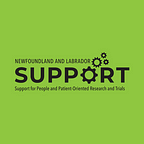Improving Emergency Department Wait Times Through Patient Engagement
Written by: Anna Walsh, Oliver Hurley, Dr. Shabnam Asghari
Reviewed & approved by the SurgeCon Patient Engagement Working Group
Submitted on behalf of the SurgeCon Research Team
Wait times and overcrowding are challenges in emergency departments around the world. To address excessively long wait times in emergency departments in Newfoundland and Labrador, our research team will implement and evaluate a quality improvement initiative called SurgeCon. SurgeCon is an emergency department management platform which includes three separate interventions that together act to improve departmental efficiency and patient satisfaction. These interventions include restructuring the emergency department organization and workflow, fostering a patient-centric environment, and quantifying emergency department demands and available resources in real-time. The primary goal of the SurgeCon project is to lower emergency department wait times, improve patient satisfaction, and improve the value of emergency healthcare spending. SurgeCon will be implemented into four different emergency departments across the Eastern Health region.
“The less we can make people feel forgotten in the ED the better.” — NL ED Patient
The SurgeCon project is a collaborative research endeavour being undertaken by Memorial University researchers, Eastern Health, the Newfoundland and Labrador provincial government, and other local, regional, and national organizations. The project is primarily funded through the Canadian Institutes of Health Research (CIHR) Strategy for Patient-Oriented Research (SPOR) network, which requires the engagement of patients and members of our communities as proactive research partners. We have designed the study to give patients a variety of opportunities to engage with us, ranging from limited commitment (e.g. surveys, interviews, etc.) to full, ongoing participation with team membership. We used four essential pillars to shape our patient engagement strategy:
- Patient Initiation (allowing patients to participate in the research process),
- Building Reciprocal Relationships (all individuals being treated as equal partners),
- Co-learning (researchers and patients learning from each other), and
- Re-assessment & Feedback (routinely consulting with patients and making improvements accordingly).
Patient research partners are key members of our research team who are also patients who use local emergency departments. They provide contextually relevant perspectives and help guide decisions. They were also essential in helping to center the study on elements that matter most to patients. For example, patient research partners co-developed a formal citizen engagement process and standardized tool to identify emergency department outcomes, and they helped identify critical components of patient-centered emergency care.
To determine what outcomes we would be examining in this study, we conducted a systematic review of the literature for relevant emergency department outcomes. We compiled a list that was then presented by Dorothy Senior, our Principal Patient Knowledge User, who is a lead patient partner on our research team, to a local patient advisory board. This board consists of other local patients who were connected to our project with the help of NL SUPPORT. The board provided anonymized feedback, expanded the indicator list, and let us know which should be prioritized from a patient perspective. Members of our team reviewed and compared the findings from the survey and selected which outcomes were to be used as the main outcomes of the study. In addition to the selection of study outcomes, another key part of the study that involved patient partners was to examine how the emergency department could be more patient-centered. This involved creating a set of defining components that comprise patient-centered care, as identified by patients. First, we conducted another systematic review of the literature to determine what patient-centered care is in other emergency departments, then we compiled a list of components that make up patient-centered care (e.g., communication, respect, emotional support, comfortable environment). This list was discussed with the Patient Engagement Working Group for SurgeCon, which is made up of patient engagement experts, clinicians, researchers, and patient partners. They were able to provide feedback on the identified components and add other considerations to the list. This proactive participation of patients and community members ensures that all elements of the research initiative moving forward will address the needs and priorities of our local population.
While our research project is still in early stages, patient engagement has already proven to have a powerful impact and it will undoubtedly grow throughout the course of the study. Our patient engagement strategy actively engages and listens to the feedback and advice provided by our patient advisors, community members, regional health authority representatives, health data custodians, and health system managers. Working with patient partners can only strengthen our research.
As part of Memorial University’s Research Week, join Dr. Shabnam Asghari, Dr. Chris Patey, Ron Johnson (VP, Eastern Health), Dorothy Senior (Patient Advisor) and other members of the SurgeCon research team on November 25th at 1:00pm NST, to learn more about what we are doing to improve the patient experience and work flow in emergency departments. Register/log-in to the session here.
Subscribe to our monthly newsletter at http://bit.ly/SupportLettersSubscribe.
